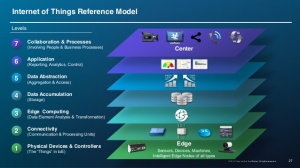IoT-A Reference Model
– Physical Devices and Controllers
The physical devices and controllers that might control multiple devices.
These are the “things” in the IoT, and they include a wide range of endpoint devices that send and receive information.
– Connectivity
Communications and connectivity, the objective of the IoT Reference Model is for communications and processing to be executed by existing networks.
– Computing
● Evaluation: Evaluating data for criteria as to whether it should be processed at a higher level
● Formatting: Reformatting data for consistent higher-level processing
● Expanding/decoding: Handling cryptic data with additional context (such as the origin)
● Distillation/reduction: Reducing and/or summarizing data to minimize the impact of data and traffic on the
network and higher-level processing systems
● Assessment: Determining whether data represents a threshold or alert; this could include redirecting data to additional destinations
– Data Accumulation
If data is of interest to higher levels: processing is the first level that is configured to serve the
specific needs of a higher level.
● If data must be persisted: Should data be kept on disk in a non-volatile state or accumulated in memory for short-term use?
● The type of storage needed: Does persistency require a file system, big data system, or relational database?
● If data is organized properly: Is the data appropriately organized for the required storage system?
● If data must be recombined or recomputed: Data might be combined, recomputed, or aggregated with previously stored information, some of which may have come from non-IoT sources.
– Data Abstraction
The data abstraction level must process many different things.
● Reconciling multiple data formats from different sources
● Assuring consistent semantics of data across sources
● Confirming that data is complete to the higher-level application
● Consolidating data into one place (with ETL, ELT, or data replication) or providing access to multiple data stores through data virtualization
● Protecting data with appropriate authentication and authorization
● Normalizing or denormalizing and indexing data to provide fast application access
– Application((Reporting, Analytics, Control)
Mission-critical business applications, such as generalized ERP or specialized industry solutions
● Mobile applications that handle simple interactions
● Business intelligence reports, where the application is the BI server
● Analytic applications that interpret data for business decisions
● System management/control center applications that control the IoT system itself and don’t act on the data produced by it.
– Collaboration and Processes(Involving people and business processes)
The IoT system, and the information it create, is of little value unless it yields action, which often requires people and processes.
Applications execute business logic to empower people. People use applications and associated data for their specific needs. Often, multiple people use the same application for a range of different purposes. So the objective is not the application—it is to empower people to do their work better. Applications give business people the right data, at the right time, so they can do the right thing.
